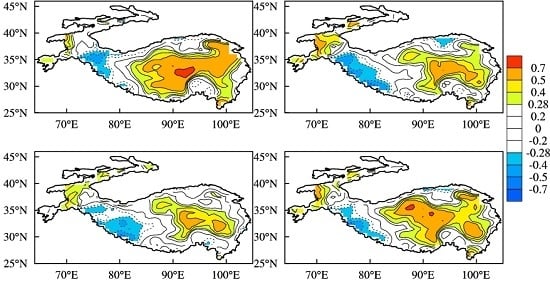Analysis of the Qinghai-Xizang Plateau Monsoon Evolution and Its Linkages with Soil Moisture
Abstract
:1. Introduction
2. Data and Methodology
2.1. Data
2.2. Methodology
2.2.1. MK Trend Test
2.2.2. SQMK Test
2.3. Plateau Monsoon Indices (PMI)
2.3.1. Calculation of the TPMI
2.3.2. Calculation of the DPMI
2.3.3. Calculation of the QPMI
2.3.4. The Definition of the ZPMI
3. Results and Discussion
3.1. Contrast Analysis and Evolution Characteristics of Plateau Monsoon Indices
3.1.1. Variation Characteristics of the Plateau Monsoon
3.1.2. Correlation Analysis between the Plateau Monsoon and Meteorological Elements
3.2. Correlation Analysis between the Plateau Monsoon and Soil Moisture
4. Conclusions
Acknowledgments
Author Contributions
Conflicts of Interest
Appendix A. A Discussion on the Strengthening Trend of Plateau Summer Monsoon and the Weakening Trend of the Asian Summer Monsoon
Appendix B. A Discussion on the Robustness of the Conclusion Points
| ZPMI | TPMI | DPMI | QPMI | |
|---|---|---|---|---|
| r | 0.54 * | 0.41 * | 0.36 * | 0.51 * |
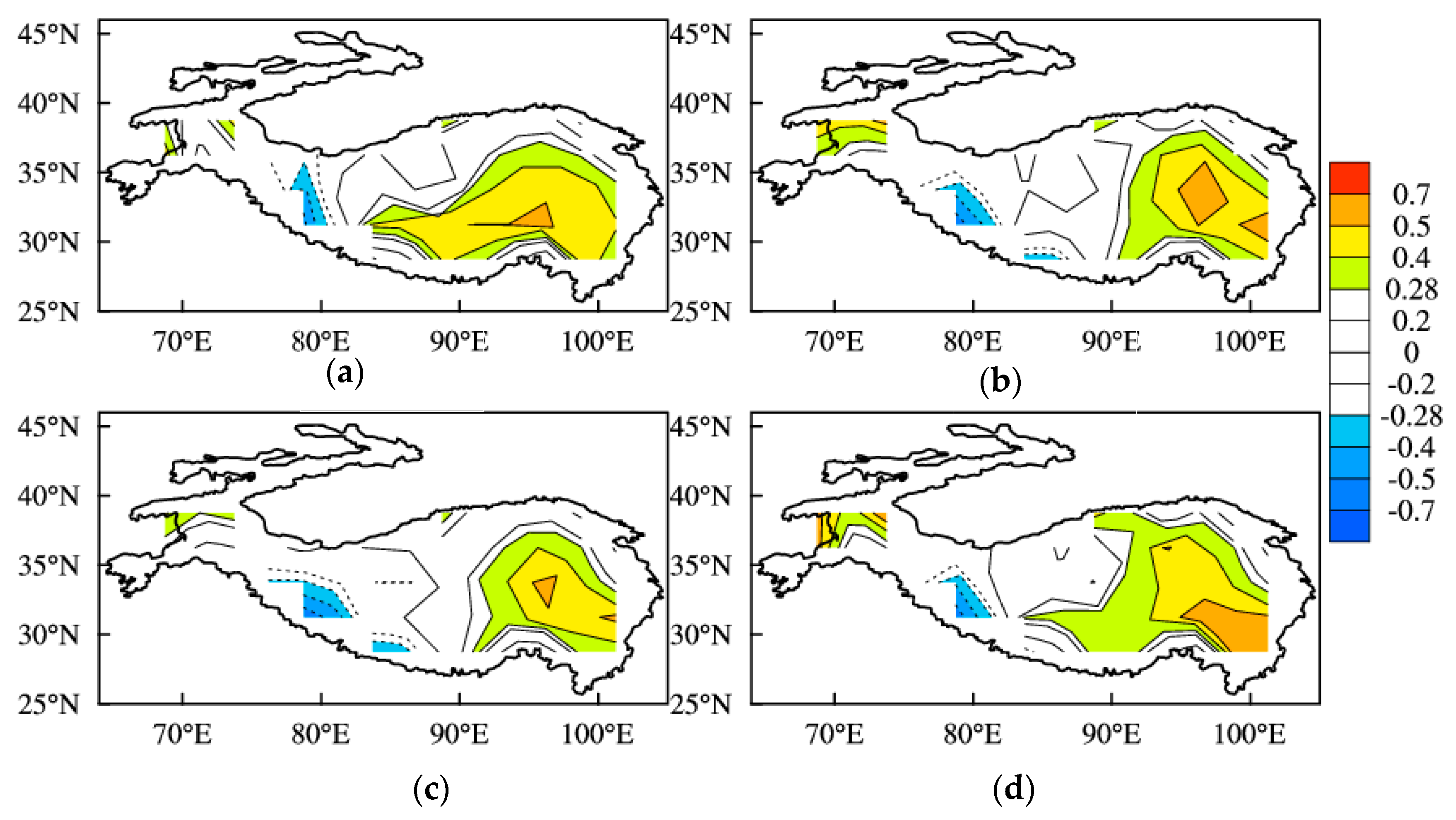
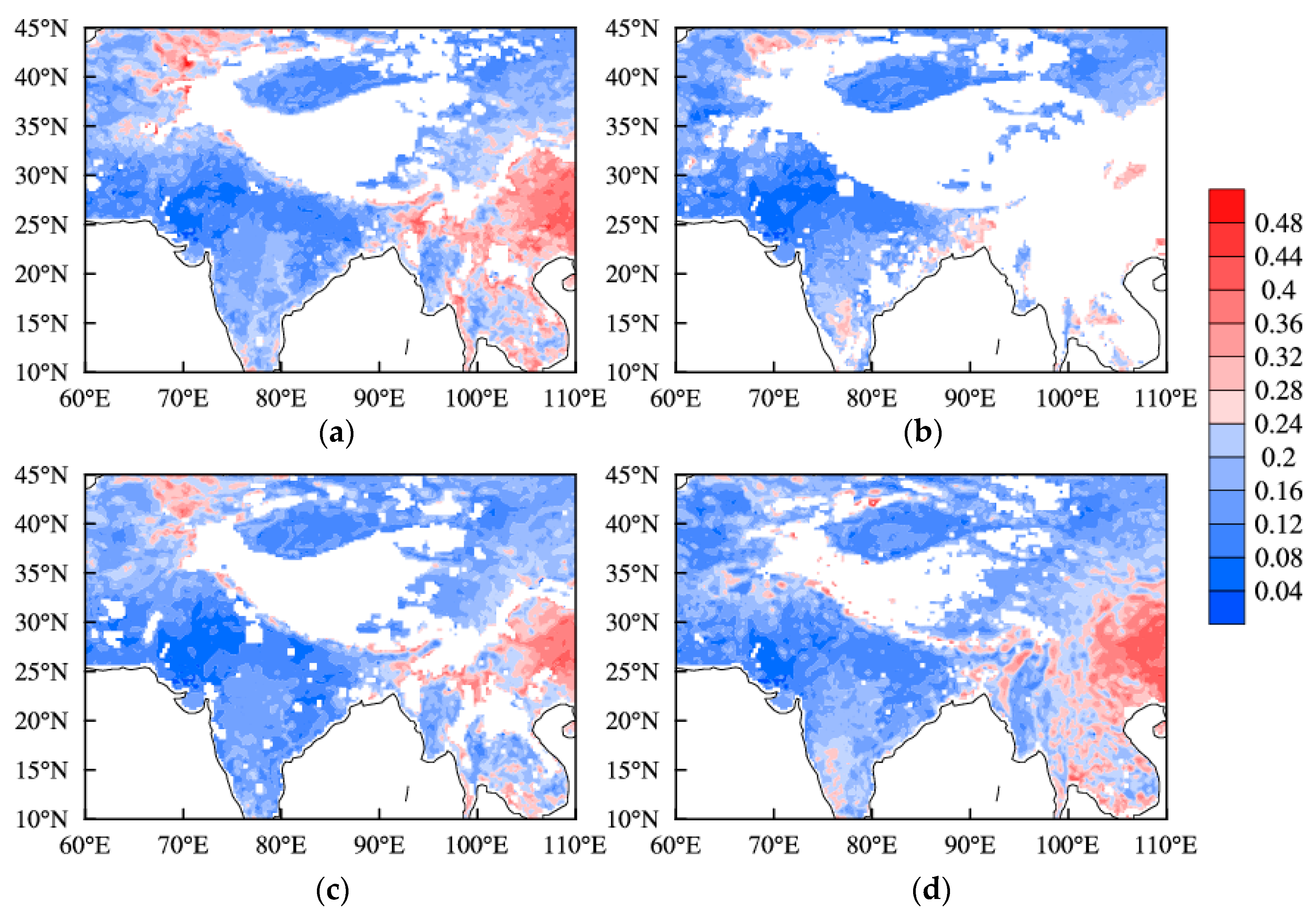
References
- Ye, D.Z.; Luo, S.W.; Zhu, B.Z. The wind structure and heat balance in the lower troposphere over Tibetan Plateau and its surrounding. J. Meteorol. Res. 1957, 28, 108–121. (In Chinese) [Google Scholar]
- Xu, S.Y.; Gao, Y.X. The monsoon phenomenon in Tibetan Plateau. Acta Geogr. Sin. 1962, 28, 111–123. (In Chinese) [Google Scholar]
- Tang, M.C.; Shen, Z.B.; Chen, Y.Y. On climatic characteristics of the Xizang Plateau monsoon. Acta Geogr. Sin. 1979, 34, 34–41. (In Chinese) [Google Scholar]
- Ye, D.Z.; Gao, Y.X. Qinghai-Xizang Plateau Meteorology; Science Press: Beijing, China, 1979; pp. 1–278. [Google Scholar]
- Tang, M.C.; Reiter, E.R. Plateau monsoons of the Northern Hemisphere: a comparison between North America and Tibet. Mon. Weather Rev. 1984, 112, 617–637. [Google Scholar] [CrossRef]
- Kuo, H.L.; Qian, Y.F. Influence of the Tibetan Plateau on cumulative and diurnal changes of weather and climate in summer. Mon. Weather Rev. 1981, 109, 2337–2356. [Google Scholar] [CrossRef]
- Tang, M.C.; Liang, J.; Shao, M.J.; Shi, G. Preliminary analysis on inter-annual variation of Plateau monsoon. Plateau Meteorol. 1984, 3, 76–82. (In Chinese) [Google Scholar]
- Tang, M.C. Discussion on inter-decade oscillation of Plateau monsoon and its causes. Sci. Meteorol. Sin. 1995, 15, 64–68. (In Chinese) [Google Scholar]
- Bai, H.Z.; Xie, J.N.; Li, D.L. The principal feature of Qinghai-Xizang Plateau monsoon variation in 40 years. Plateau Meteorol. 2001, 20, 22–27. (In Chinese) [Google Scholar]
- Xun, X.Y.; Hu, Z.Y.; Ma, Y.M. The Dynamic Plateau Monsoon Index and its association with general circulation anomalies. Adv. Atmos. Sci. 2012, 29, 1249–1263. [Google Scholar] [CrossRef]
- Qi, D.M.; Li, Y.Q.; Bai, Y.Y.; De, D. The definition of plateau summer monsoon index and analysis on its characteristics. Plateau Mt. Meteorol. Res. 2009, 29, 1–9. (In Chinese) [Google Scholar]
- Ma, Z.G.; Fu, C.B.; Xie, L.; Chen, W.H.; Tao, S.W. Some problems in the study on the relationship between soil moisture and climate change. Adv. Earth Sci. 2001, 16, 563–568. (In Chinese) [Google Scholar]
- Koster, R.D.; Suarez, M.J. Soil moisture memory in climate models. J. Hydrol. 2001, 2, 558–570. [Google Scholar] [CrossRef]
- Douville, H. Influence of soil moisture on the Asian and African monsoons. Part II: Interannual variability. J. Clim. 2002, 15, 701–720. [Google Scholar] [CrossRef]
- Douville, H. Assessig the influence of soil moisture on seasonal climate variability with AGCMs. J. Hydrometeorol. 2003, 4, 1044–1066. [Google Scholar] [CrossRef]
- Douville, H.; Chauvin, F. Relevance of soil moisture for seasonal climate predictions: A preliminary study. Clim. Dyn. 2000, 16, 719–736. [Google Scholar] [CrossRef]
- Douville, H.; Chauvin, F.; Broqua, H. Influence of soil moisture on the Asian and African monsoons. Part I: Mean monsoon and daily precipitation. J. Clim. 2001, 14, 2381–2403. [Google Scholar] [CrossRef]
- Le, Y.L.; Luo, Y.; Guo, P.W. A study on the relationship between spring soil moisture over China and East Asia Summer Monsoon. J. Trop. Meteorol. 2007, 23, 474–482. (In Chinese) [Google Scholar]
- Chow, K.C.; Johnny, C.; Chan, L.; Shi, X.L.; Liu, Y.M.; Ding, Y.H. Time-lagged effects of spring Tibetan Plateau soil moisture on the monsoon over China in early summer. Int. J. Climatol. 2008, 28, 55–67. [Google Scholar] [CrossRef]
- Cui, Y. Study on the relationships between the land surface process of Qinghai-Xizang Plateau and the Asian summer monsoon. Ph.D. Thesis, Lanzhou University, Gansu, China, 2010. [Google Scholar]
- Zhang, R.H.; Zou, Z.Y. Impact of spring soil moisture on surface energy balance and summer monsoon circulation over East Asia and precipitation in East China. J. Clim. 2011, 24, 3309–3322. [Google Scholar] [CrossRef]
- Liu, G.; Chen, J.M.; Ji, L.R.; Sun, S.Q. Relationship of summer soil moisture with early winter monsoon and air temperature over eastern China. Int. J. Climatol. 2012, 32, 1512–1519. [Google Scholar] [CrossRef]
- Zhan, Y.L.; Lin, Z.H. The relationship between June precipitation over mid-lower reaches of the Yangtze River basin and spring soil moisture over the East Asian monsoon region. Acta Meteorol. Sin. 2012, 70, 236–243. (In Chinese) [Google Scholar] [CrossRef]
- Xun, X.Y.; Hu, Z.Y.; Cui, G.F.; He, H.G.; Sun, J.; Hao, L.; Gu, L.L. Change of monsoon in Qinghai-Xizang Plateau and its correlation with summer precipitation of Ordos Plateau. J. Arid Land Resour. Environ. 2011, 25, 79–83. (In Chinese) [Google Scholar]
- Hua, W.; Fan, G.Z.; Wan, B.Y. Variation of Tibetan Plateau summer monsoon and its effect on precipitation in East China. Chin. J. Atmos. Sci. 2012, 36, 784–794. (In Chinese) [Google Scholar]
- Zhao, T.B.; Fu, C.B. Preliminary comparison and Analysis between ERA-40, NECP-2 Reanalysis and observations over China. Clim. Environ. Res. 2006, 11, 14–32. (In Chinese) [Google Scholar]
- Li, H.B.; Robock, A.; Liu, S.X.; Mo, S.X.; Viterbo, P. Evaluation of reanalysis soil moisture simulations using updated Chinese soil moisture observations. J. Hydrometeorol. 2004, 6, 180–193. [Google Scholar] [CrossRef]
- Zhang, W.J.; Zhou, T.J.; Yu, R.C. Spatial distribution and temporal variation of soil moisture over China Part I: Multi-data Intercomparison. Chin. J. Atmos. Sci. 2008, 32, 581–597. (In Chinese) [Google Scholar]
- Su, Z.; Rosnay, P.; Wen, J.; Wang, L.; Zeng, Y. Evaluation of ECMWF’s soil moisture analyses using observations on the Tibetan Plateau. J. Geophys. Res. 2013, 118, 5304–5308. [Google Scholar] [CrossRef]
- Zeng, Y.J.; Su, Z.B.; van der Velde, R.; Wang, L.C.; Xu, K.; Wang, X.; Wen, J. Blending satellite observed, model simulated, and in situ measured soil moisture over Tibetan Plateau. Remote Sens. 2016, 8, 268. [Google Scholar] [CrossRef]
- Liu, C.; Yu, Y.; Xie, J.; Zhou, X.; Li, J.L.; Ge, J. Applicability of soil temperature and moisture in several datasets over Qinghai-Xizang Plateau. Plateau Meteorol. 2015, 34, 653–665. (In Chinese) [Google Scholar]
- Zuo, Z.Y.; Zhang, R.H. The temporal and spatial variation characteristics of soil moisture over Eastern China. Sci. China (Ser. D Earth Sci.) 2008, 38, 1428–1437. (In Chinese) [Google Scholar]
- Dee, D.P.; Uppala, S.M.; Simmons, A.J.; Berrisford, P.; Paul, P. Shinya Kobayashi The ERA-Interim reanalysis: Configuration and performance of the data assimilation system. Q. J. R. Meteorol. Soc. 2011, 137, 553–597. [Google Scholar] [CrossRef]
- Wei, F.Y. Technology of Statistical Diagnosis and Prediction of Modern Climate; China Meteorological Press: Beijing, China, 1999; pp. 62–73. [Google Scholar]
- Blain, G.C. Removing the influence of the serial correlation on the Mann-Kendall test. Rev. Bras. Meteorol. 2014, 29, 161–170. [Google Scholar] [CrossRef]
- Zhu, Q.G.; Lin, J.R. The Theories and Methods of Synoptic Meteorology; China Meteorological Press: Beijing, China, 2000; pp. 462–555. [Google Scholar]
- Webster, P.J.; Magana, V.O.; Palmer, T.N.; Shukla, J.; Tomas, R.A.; Yanai, M.; Yasunari, T. Monsoons: Processes, predictability, and the prospects for prediction. J. Geophys. Res. 1998, 103, 14451–14510. [Google Scholar] [CrossRef]
- Jiang, Y.J.; Li, S.J.; Shen, D.F.; Chen, W.; Jin, C.F. Climate change and its impact on the lake environment in the Tibetan Plateau in 1971–2009. Sci. Geogr. Sin. 2012, 32, 1503–1512. (In Chinese) [Google Scholar]
- Jiang, Y.J.; Li, S.J.; Shen, D.F.; Chen, W. Climate change and its impact on the regional environment in the source regions of the Yangtze, Yellow and Lantsang Rivers in Qinghai—Tibetan Plateau during 1971–2008. J. Mt. Sci. 2012, 30, 461–469. (In Chinese) [Google Scholar]
- Liu, J.S.; Wang, S.Y.; Yu, S.M.; Yang, D.Q.; Zhang, L. Climate warming and growth of high-elevation inland lakes on the Tibetan Plateau. Glob. Planet. Chang. 2009, 67, 209–217. [Google Scholar] [CrossRef]
- Li, J.P.; Zeng, Q.C. A unified monsoon index. Geophys. Res. Lett. 2002, 29, 1274. [Google Scholar] [CrossRef]
- Vinnikov, K.Y.; Robock, A.; Speranskaya, N.A.; Schlosser, C.A. Scales of temporal and spatial variability of midlatitude soil moisture. J. Geophys. Res. 1996, 101, 7163–7174. [Google Scholar] [CrossRef]
- Zhuo, G.; Chen, T.; Zhou, K.S.; Luo, Z. Spatial and temporal distribution of soil moisture over the Tibetan Plateau during 2009–2010. J. Glaciol. Geocryol. 2015, 37, 625–634. (In Chinese) [Google Scholar]
- Grimm, A.M.; Jeremy, S.P.; Filippo, G. Connection between spring conditions and peak summer monsoon rainfall in South America: Role of soil moisture, surface temperature, and topography in eastern Brazil. J. Clim. 2007, 20, 5929–5945. [Google Scholar] [CrossRef]
- Cen, S.X.; Gong, Y.F.; Lai, X.; Qi, D.M. The relationship of the thermal contrast between the eastern Tibetan Plateau and its northern side with the plateau monsoon and the precipitation in the Yangtze River basin in summer. Acta Meteorol. Sin. 2014, 72, 256–265. (In Chinese) [Google Scholar]
- Ma, Z.F.; Gao, W.L. Relationship between interannual change over Qinghai-Xizang Plateau monsoon and climate change in upper rech of Changjiang River. Plateau Meteorol. 2003, 22, 8–16. (In Chinese) [Google Scholar]
- Miao, Q.L.; Jiang, Z.H.; Chen, H.S.; Yu, J.H. Contemporary Climatology; China Meteorological Press: Beijing, China, 2011; pp. 163–178. [Google Scholar]
- Yeh, T.C.; Wetherald, R.T.; Manabe, S. The effect of soil moisture on the short-term climate and hydrology change-A numerical experiment. Mon. Weather Rev. 1983, 112, 474–490. [Google Scholar] [CrossRef]
- Zhao, P.; Zhu, Y.N.; Zhang, R.H. An Asian-Pacific teleconnection in summer tropospheric temperature and associated Asian climate variability. Clim. Dyn. 2007, 29, 293–303. [Google Scholar] [CrossRef]
- Duan, A.M.; Wu, G.X. Role of the Tibetan Plateau thermal forcing in the summer climate patterns over subtropical Asia. Clim. Dyn. 2005, 24, 793–807. [Google Scholar] [CrossRef]
- Tang, M.C. Some advances on the research of plateau monsoons (A Review). Plateau Meteorol. 1993, 12, 95–101. (In Chinese) [Google Scholar]
- Adler, R.F.; Huffman, G.J.; Chang, A.; Ferraro, R.; Xie, P.P.; Janowial, J.; Rudolf, B.; Schneider, U.; Curtis, S.; Bolvin, D.; et al. The version-2 Global Climatology Project (GPCP) monthly precipitation analysis (1979-Present). J. Hydrometeorol. 2003, 4, 1147–1167. [Google Scholar] [CrossRef]
- Liu, Y. Y.; Dorigo, W.A.; Parinussa, R.M.; de Jeu, R.A.M.; Wagner, W.; McCabe, M.F.; Evans, J.P.; van Dijk, A.I.J.M. Trend-preserving blending of passive and active microwave soil moisture retrievals. Remote Sens. Environ. 2012, 123, 280–297. [Google Scholar] [CrossRef]
- Wagner, W.; Dorigo, W.A.; de Jeu, R.; Fernandez, D.; Benveniste, J.; Haas, E.; Ertl, M. Fusion of active and passive microwave observations to create an Essential Climate Variable data record on soil moisture. ISPRS Ann. Photygramm. Remote Sens. Spat. Inf. Sci. 2012, I-7, 315–321. [Google Scholar] [CrossRef]

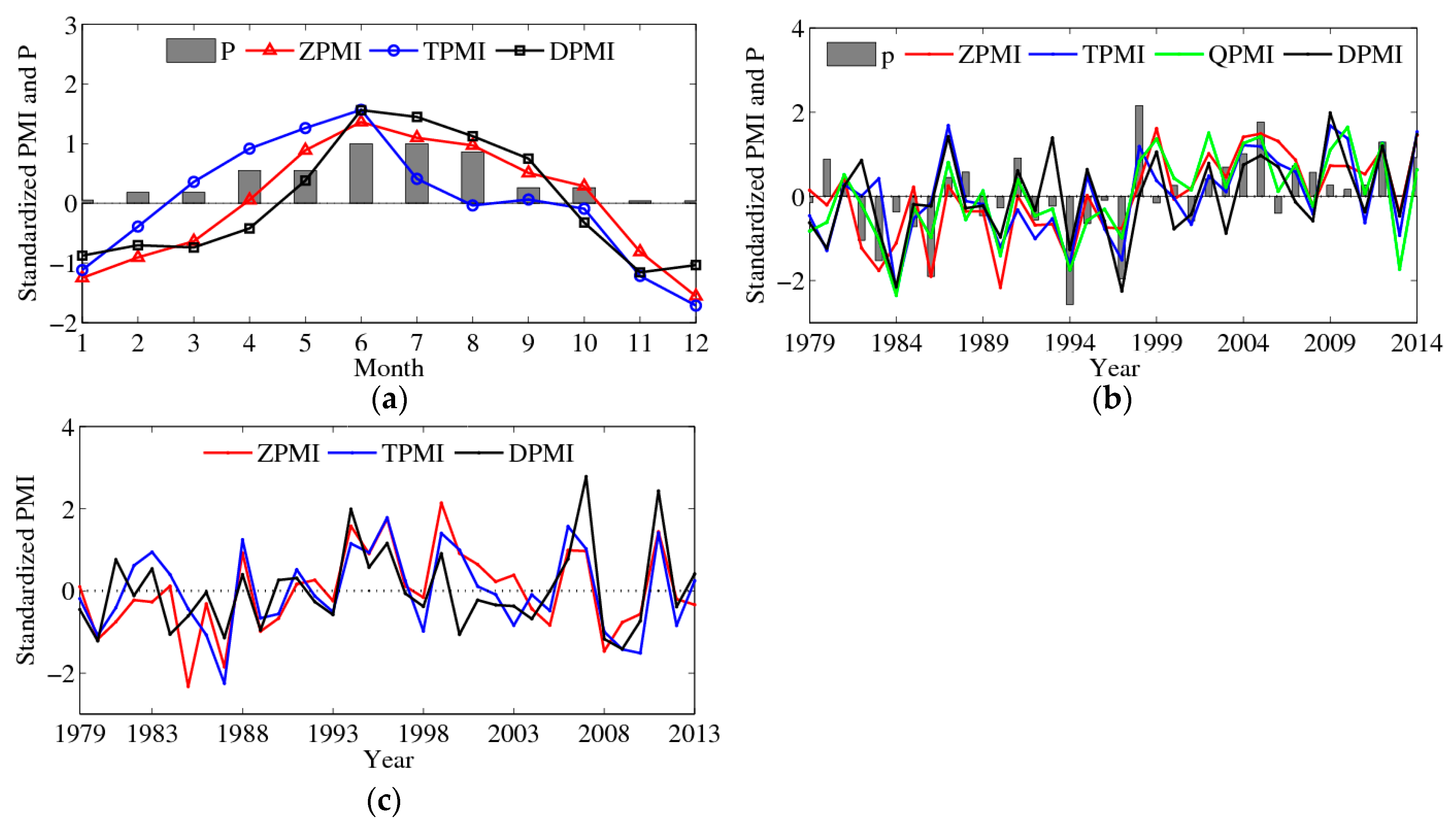
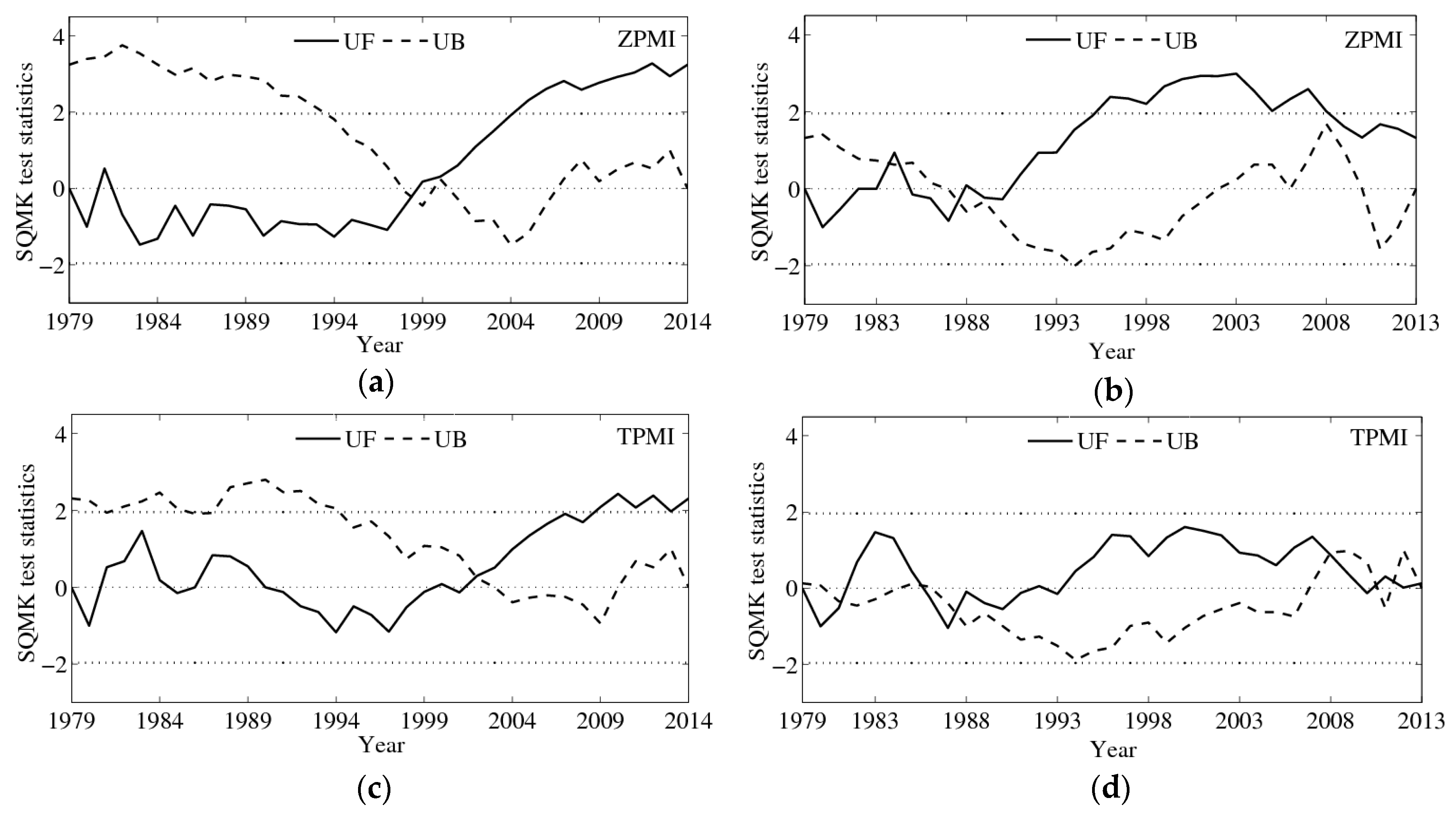

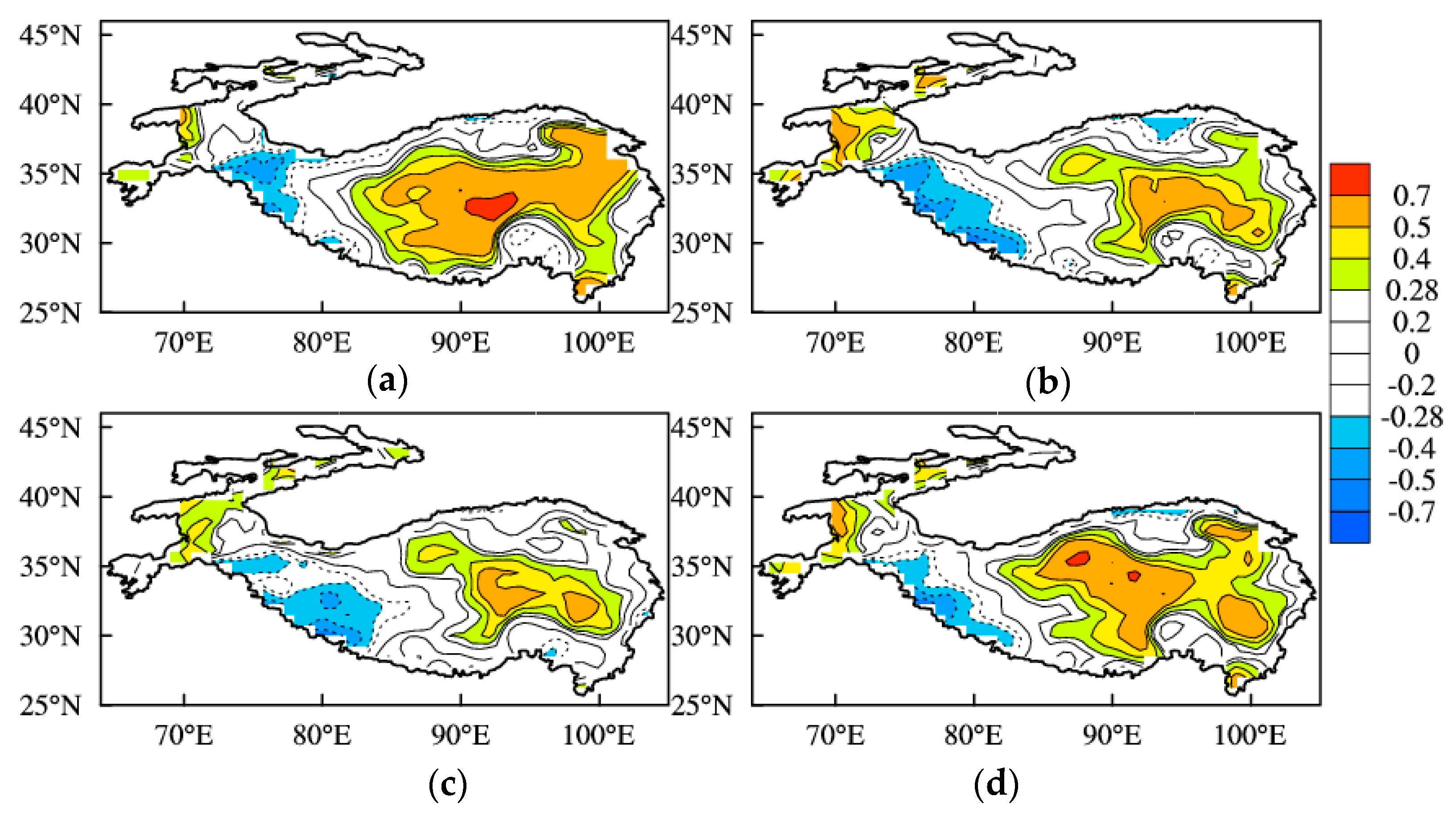
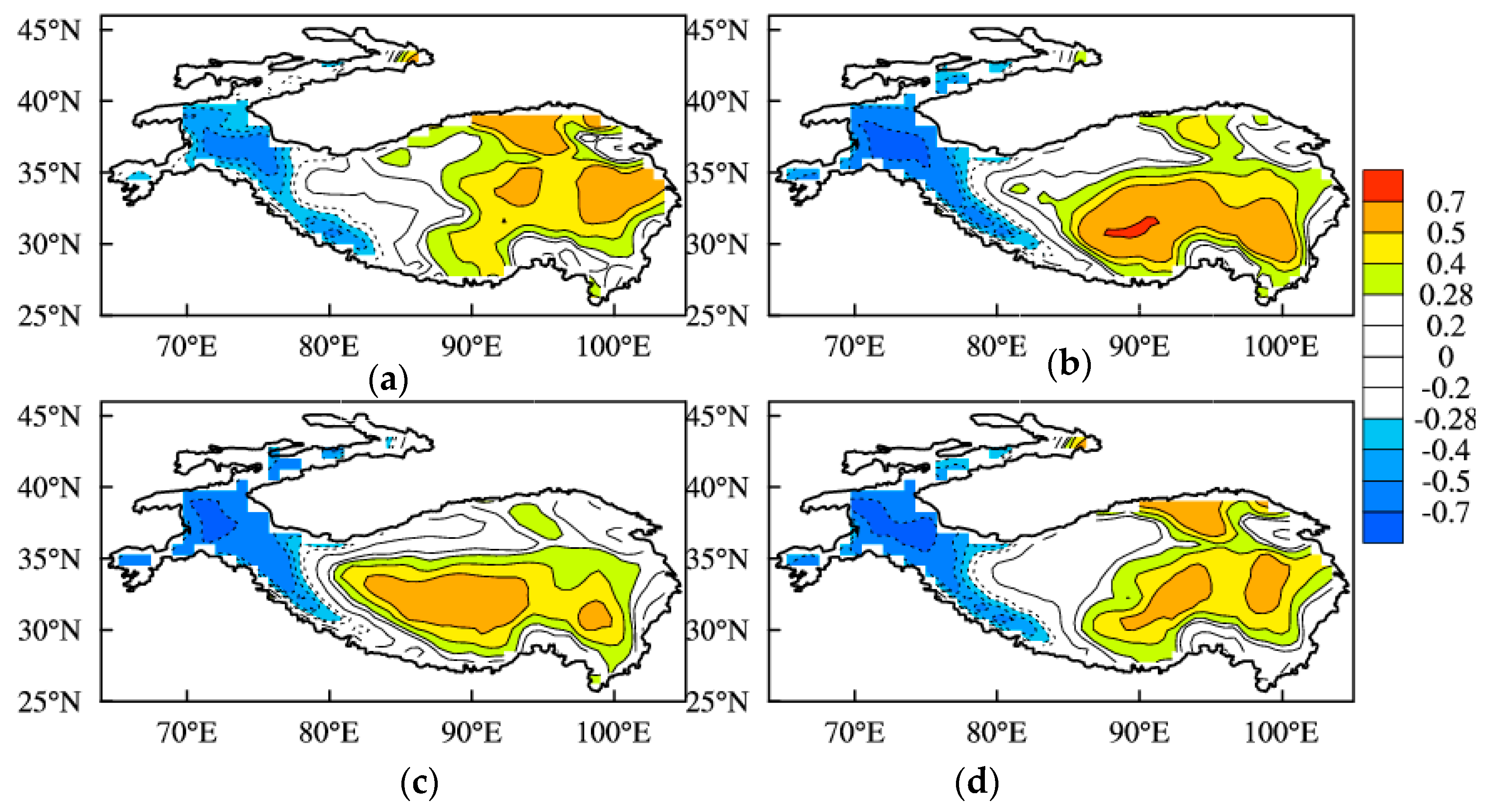


| ZPMI | TPMI | DPMI | QPMI | |
|---|---|---|---|---|
| r | 0.67 * | 0.52 * | 0.42 * | 0.62 * |
| ZPMI | TPMI | DPMI | QPMI | |
|---|---|---|---|---|
| Summer | 3.23 * | 2.30 * | 1.78 | 2.82 * |
| Winter | 1.31 | 0.11 | 0.43 |
© 2016 by the authors; licensee MDPI, Basel, Switzerland. This article is an open access article distributed under the terms and conditions of the Creative Commons Attribution (CC-BY) license (http://creativecommons.org/licenses/by/4.0/).
Share and Cite
Zhou, J.; Wen, J.; Wang, X.; Jia, D.; Chen, J. Analysis of the Qinghai-Xizang Plateau Monsoon Evolution and Its Linkages with Soil Moisture. Remote Sens. 2016, 8, 493. https://doi.org/10.3390/rs8060493
Zhou J, Wen J, Wang X, Jia D, Chen J. Analysis of the Qinghai-Xizang Plateau Monsoon Evolution and Its Linkages with Soil Moisture. Remote Sensing. 2016; 8(6):493. https://doi.org/10.3390/rs8060493
Chicago/Turabian StyleZhou, Juan, Jun Wen, Xin Wang, Dongyu Jia, and Jinlei Chen. 2016. "Analysis of the Qinghai-Xizang Plateau Monsoon Evolution and Its Linkages with Soil Moisture" Remote Sensing 8, no. 6: 493. https://doi.org/10.3390/rs8060493
APA StyleZhou, J., Wen, J., Wang, X., Jia, D., & Chen, J. (2016). Analysis of the Qinghai-Xizang Plateau Monsoon Evolution and Its Linkages with Soil Moisture. Remote Sensing, 8(6), 493. https://doi.org/10.3390/rs8060493




